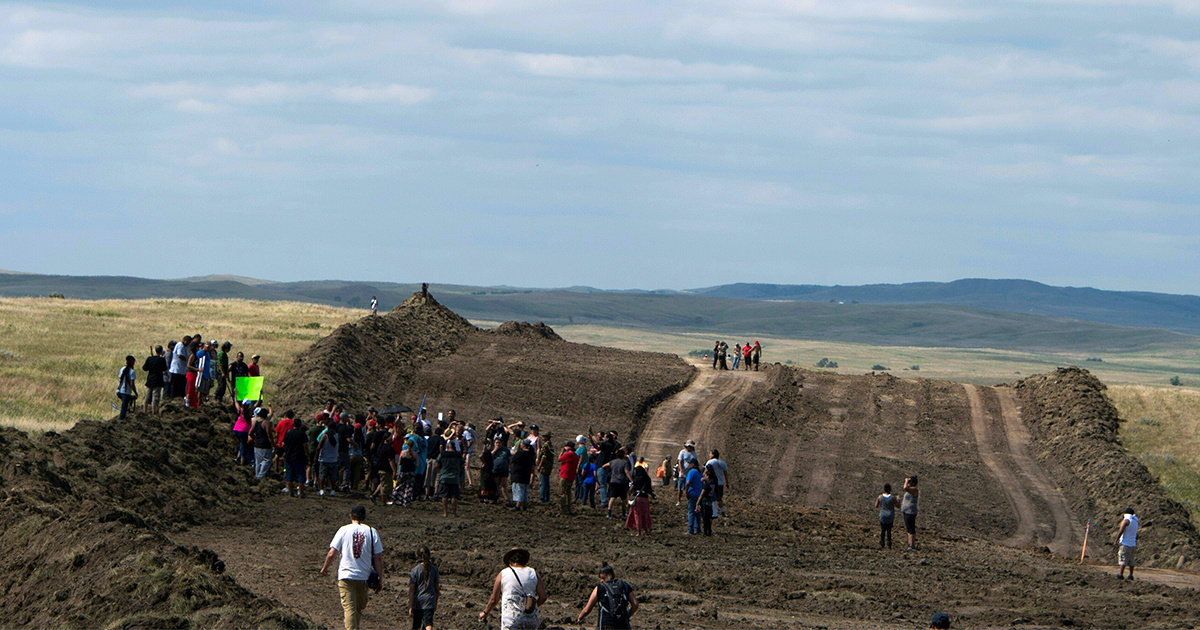
Dakota Access Pipeline Company Misses Deadline to Plant 20,000 Trees Along Pipeline Route

Protesters walk along land being prepared for the Dakota Access Pipeline in North Dakota on Sept. 3, 2016. ROBYN BECK / AFP / Getty Images
Energy Transfer Partners, the company behind the controversial Dakota Access Pipeline, has missed its 2018 deadline to plant tens of thousands of trees along the pipeline‘s route, The Associated Press reported Tuesday.
The company was supposed to plant 20,000 trees along the pipeline’s 359-mile route through North Dakota by the end of 2018, as per the terms of a September 2017 settlement with North Dakota’s Public Service Commission. So far, it has planted only around 8,800.
The settlement came about because of two major complaints, The Associated Press reported in 2017:
- Energy Transfer Partners failed to adequately report the discovery of Native American artifacts along its route. The artifacts were not disturbed, but the company did not get permission from the commission for a route change.
- Regulators were concerned that the company had disturbed too many trees and improperly removed soil while laying pipe.
In the settlement, Energy Transfer Partners agreed to plant trees in soil conservation districts along the route and help write a “how-to” manual for handling the discovery of artifacts, but it did not have to pay a $15,000 fine or payment, as regulators originally proposed.
“This really is not as much about the monetary amount as it is about awareness and influencing future behavior,” Commissioner Brian Kroshus said at the time.
Now, Energy Transfer Partners is relying on a provision in the settlement allowing it more time to plant the trees if it encounters difficulties. Perennial Environmental Services, the company Energy Transfer Partners hired to manage the tree planting, said it had run into the following problems:
- Equipment and staffing problems
- Poor conditions for planting
- A lack of landlords willing to have trees planted on their land
- An incident in which one soil conservation district refused any plantings because it didn’t think the 15 tree species listed in the settlement were appropriate for the area
Perennial Environmental Services said soil conservation districts in six counties had committed to planting 16,800 trees in 2019 for a total of more than 25,500. Commission officials were not available for comment on whether or not they thought the delay was justified, The Associated Press reported.
The Dakota Access Pipeline sparked massive protests by the Standing Rock Sioux tribe and their allies over concerns it would threaten the tribe’s drinking water. The protests seemed to have been successful when the administration of former President Barack Obama denied a key permit for the project towards the end of 2016, but President Donald Trump signed an executive order greenlighting the pipeline early in his term.
Oil began flowing through the pipeline in June of 2017, which was projected to move around 520,000 barrels of oil a day along more than 1,000 miles through North Dakota to Illinois, NPR reported at the time.
Stopping a Dakota Access Pipeline Leak in Under 10 Minutes? A Fairy Tale, Say the Standing Rock Siouxhttps://t.co/7qoAkqOmUj#INDIGENOUS #TAIRP @StandingRockST pic.twitter.com/huir5ThEDe
— Indigenous (@AmericanIndian8) May 24, 2018

 233k
233k  41k
41k  Subscribe
Subscribe 